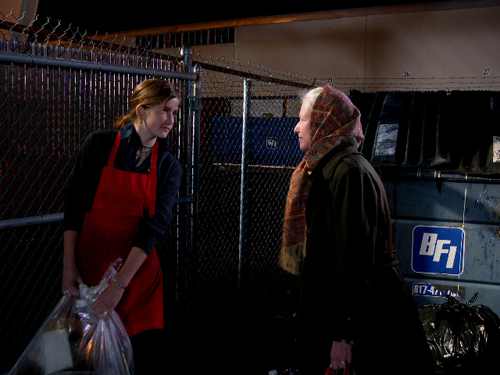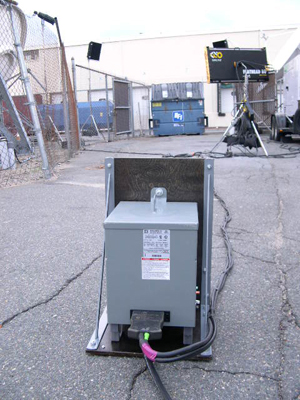Generators are relatively cheap to rent from a general rental type of store (generators, cement mixers, etc...) They often also have those giant generator driven lights that construction crews use that you could nearly turn it into daylight with
Home depot will rent you a small ginnie for $50 a day. Noise will be an issue, but can work around it.
When it comes to running HMIs on small portable generators, it matters not only what type of generator you use but also what type of HMI ballast you use. The harmonic noise that magnetic and non-PFC electronic ballasts kick back into the power stream has an adverse effect on the power waveform of the construction generators, where it does not on grid power. Normally, when you plug an HMI light into a wall outlet you need not be concerned about current harmonic distortion producing voltage distortions. The impedance of the electrical path from the power plant is so low, the distortion of the original voltage waveform so small (1-3%), and the plant capacity so large, that inherently noisy loads placed upon it will not affect the voltage at the load bus.
However, it is an all together different situation when plugging HMIs into a conventional portable generator like the one you would get from HD or a construction rental company. Given the large sub-transient impedance of conventional portable generators, even a small degree of harmonic noise being fed back into the power stream will result in a large amount of distortion in its’ voltage. Add to that, the likely hood that the percentage of the generator’s capacity taken up by non-linear loads will to be very high given its small size relative to typical lighting loads, and given the increasing prevalence of non-linear light sources in production. Finally, add that the original supply voltage waveform of a conventional generator is appreciably distorted to begin with, and you have a situation where the return of any harmonic currents by an HMI ballast will result in significant waveform distortion of the voltage at the power bus.
For this reason, when your lighting package consists predominantly of non-linear light sources, like HMI and Fluorescent lights, it is important to have power factor correction (PFC) circuitry in the ballasts and operate them on inverter generators. The combination of improved power factor and the nearly pure power waveform of inverter generators makes it possible to power larger lights, or more smaller lights, than has been possible before on a small portable gas generator.
In the past, the primary factors limiting the use of HMIs on portable generators has been their inefficient use of power and the harmonic noise they throw back into the power stream. The power waveform below left is typical of what results from the operation of a 2.5kw non Power Factor Corrected HMI load (electronic ballasts) on a conventional portable generator. The adverse effects of the severe harmonic noise exhibited here, can take the form of overheating and failing equipment, efficiency losses, circuit breaker trips, excessive current on the neutral return, and instability of the generator’s voltage and frequency. For these reasons it has never been possible to reliably operate more than a couple of 1200W HMIs on a conventional 6500W portable gas generator. Harmonic noise of this magnitude can also damage HD digital cinema production equipment, create ground loops, and possibly create radio frequency (RF) interference. The increasing use of personal computers, hard drives, and microprocessor-controlled recording equipment in production has created an unprecedented demand for clean, reliable power on set.
My company, ScreenLight & Grip (SL&G) has also developed a Gen-set that takes advantage of recent technological advances in HMI ballast design and power generation to create clean stable set power that is capable of operating larger lights (HMIs up to 6kw or Quartz lights up to 6kw), or more smaller lights, off of portable gas generators than has ever been possible before. For example, the power waveform above on the right, is the same 2500W load but with power factor correction operating on our modified Honda EU6500is Inverter Generator. As you can see, the difference between the resulting waveforms is startling. Even though the load is the same, the fact that it is power factor corrected and the power is being generated by an inverter generator, results in virtually no power waveform distortion. For this reason, sensitive electronic production equipment will operate reliably and without damage. And, the generator is capable of operating larger, or more smaller, lights than has ever been possible before on a portable gas generator.
Wide Shot of Night exterior scene lit with a pkg. consisting of PFC 2.5 & 1.2 HMI Pars, PFC 800w Joker HMI, Kino Flo Flat Head 80, 2 ParaBeam 400s, and a ParaBeam 200 powered by a modified Honda EU6500is.
Where before you could not operate more than a couple 1200W HMIs with non-PFC ballasts on a conventional generator because of the consequent harmonic distortion, now you can load an inverter generator to capacity. And if the generator is one of our modified Honda EU6500is inverter generators, you will be able to run a continuous load of up to 7500W as long as your HMI and Kino ballasts are Power Factor Corrected. But, where I have covered this in another post in this forum I won’t go into more details here. For more details read my posts at
http://www.indietalk.com/showthread.php?t=19895&page=2
For more information on the use of portable gas generators in motion picture lighting, I suggest you read an article I wrote for my company’s newsletter. The article is available at
www.screenlightandgrip.com/html/emailnewsletter_generators.html .
- Guy Holt, Gaffer, Boston


 thank you.
thank you.






